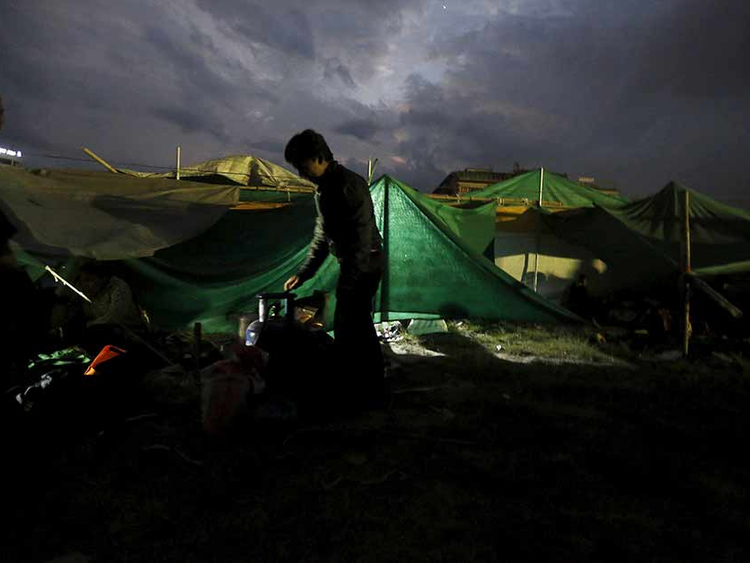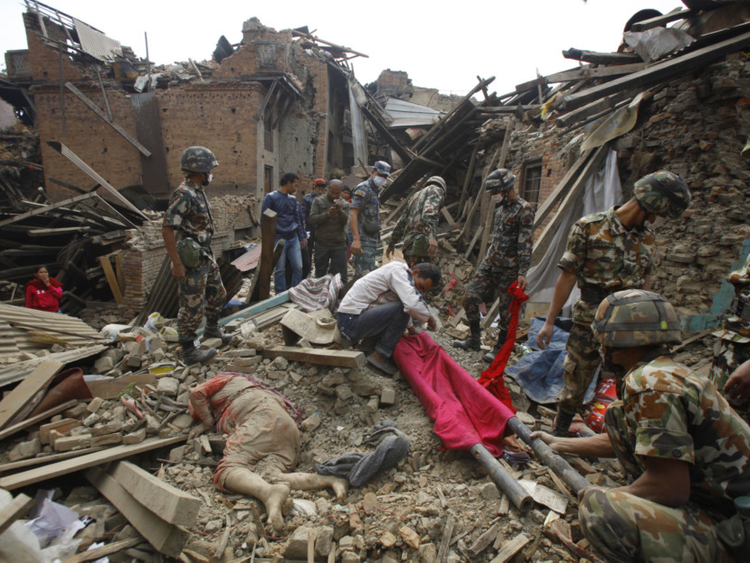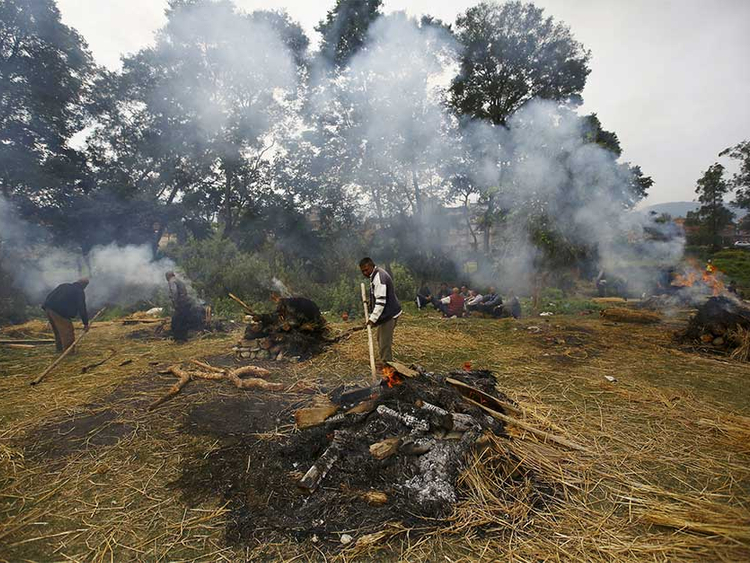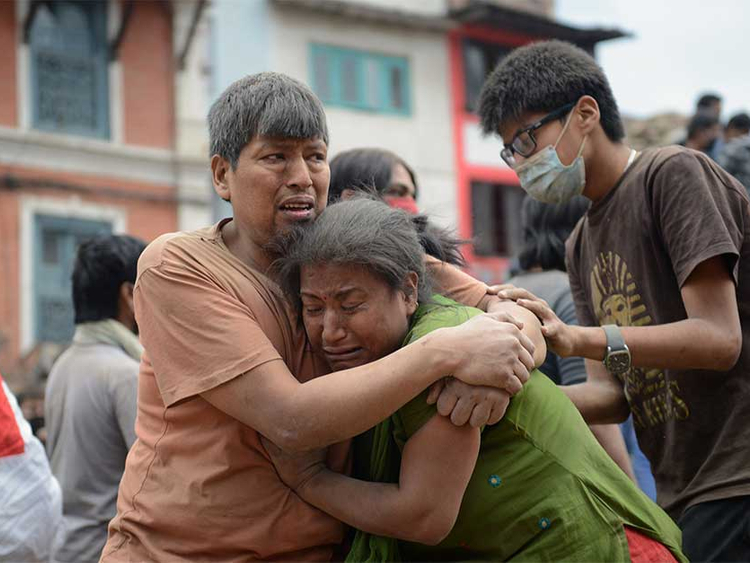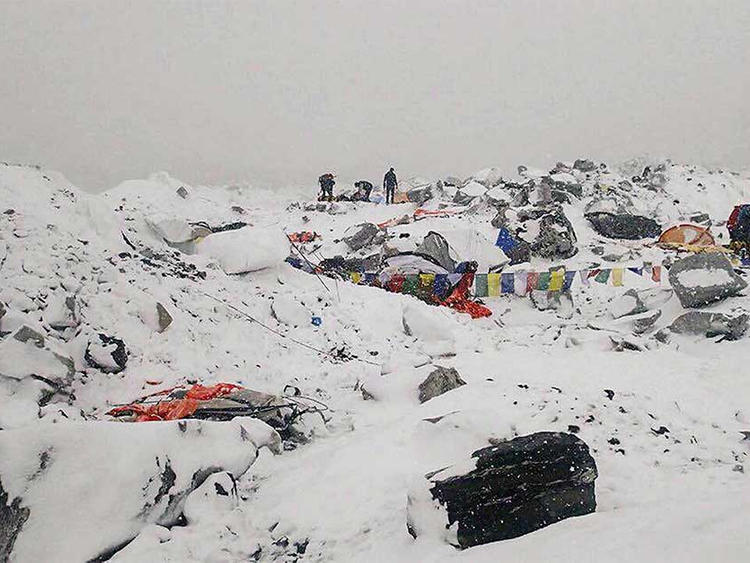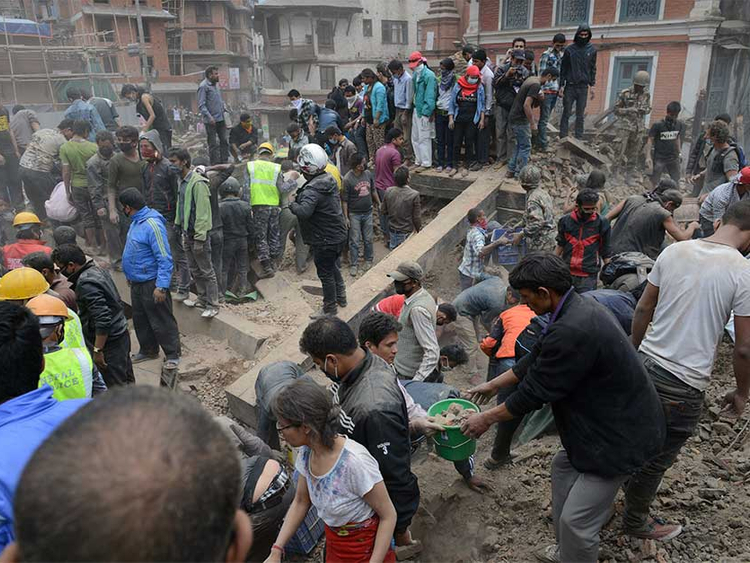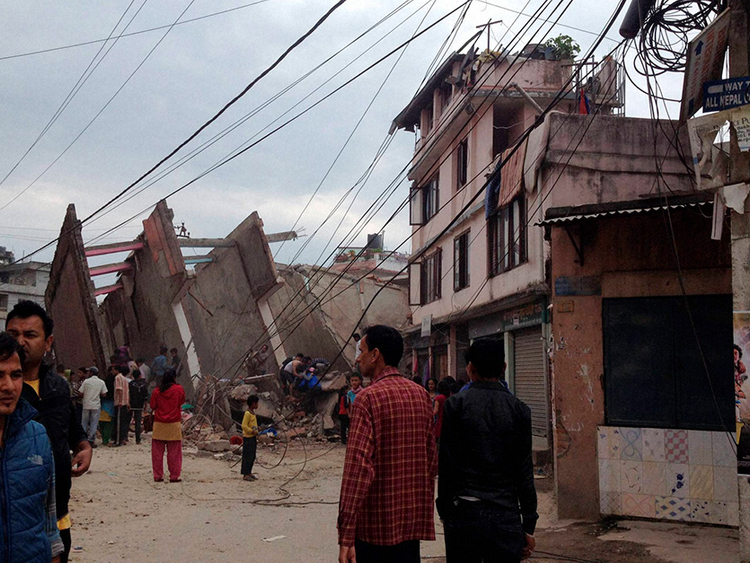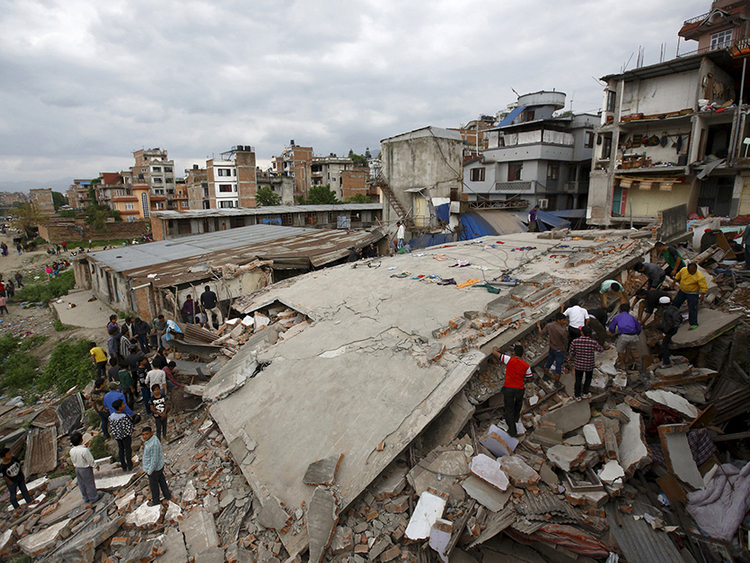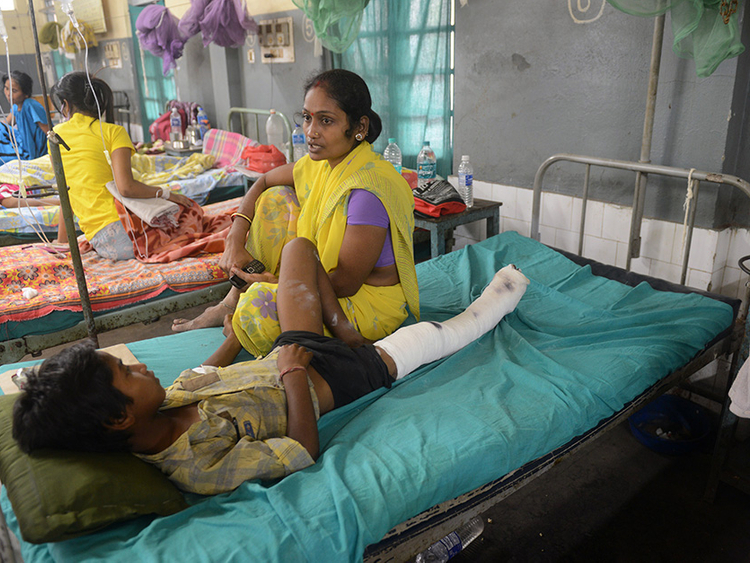
Kathmandu: The death toll from Nepal's earthquake has jumped to 3,218, a police official said on Monday.
The official said 6,538 people have been injured in Saturday's quake, the worst in the country in 81 years.
The Nepal Mountaineering Association says 18 people died in an earthquake-triggered avalanche on Mount Everest.
Another 61 people died from the quake in India and a few in other neighbouring countries. Nepal has been hit by at least 20 aftershocks, including one on Sunday afternoon that measured 6.7. That aftershock prompted a brief closure of Kathmandu airport.
Some 6.6 million people have been affected by the earthquake in Nepal, the UN office in Kathmandu said. “Rescue and relief operations may be hampered with the monsoon fast approaching,” said the UN.
As countries rushed to send help, Indian helicopters carried Nepali military authorities on reconnaissance missions into the mountains in the worst-hit areas to assess the damage. “The plan is to drop supplies in the worstaffected valleys in case landing is not possible,” said a defence ministry spokesman.
Sleeping in the streets and shell-shocked, Nepalese cremated the dead and dug through rubble for the missing Sunday, a day after a massive Himalayan earthquake killed more than 2,800 people.
Aftershocks tormented them, making buildings sway and sending panicked Kathmandu residents running into the streets. The cawing of crows mixed with terrified screams as the worst of the aftershocks - magnitude 6.7 - pummelled the capital city. It came as planeloads of supplies, doctors and relief workers from neighboring countries began arriving in this poor Himalayan nation. No deaths or injuries were reported from the early Sunday afternoon quake, but it took an emotional toll.
Earlier an official in Nepal said that at least 2,152 people are now confirmed dead in the massive earthquake that hit just outside of Kathmandu.
Deputy Inspector General of Police Komal Singh Bam gave no further details Sunday.
A 7.9 magnitude temblor struck Nepal before noon on Saturday and was most severely felt in the capital and the densely populated Kathmandu Valley. Aftershocks are rippled through the region Sunday, spreading fear and panic.
The biggest of the aftershocks was magnitude 6.7 and sent people yelling and running for open ground on Sunday.
The US Geological Survey says the aftershock registered at a shallow depth of 10 kilometres.
Nepalese dig with bare hands for survivors
Rescuers in Nepal searched frantically on Sunday for survivors of a huge quake that killed nearly 2,000, digging through rubble in the devastated capital Kathmandu and airlifting victims of an avalanche at Everest base camp. Rescuers dug with their bare hands and bodies piled up.
Army officer Santosh Nepal and a group of rescuers worked all night to open a passage into a collapsed building in the capital Kathmandu. They had to use pick axes because bulldozers could not get through the ancient city's narrow streets.
"We believe there are still people trapped inside," he told Reuters, pointing at concrete debris and twisted reinforcement rods where a three-storey residential building once stood.
Everest disaster
In Everest's worst disaster, the bodies of 17 climbers were recovered from the mountain on Sunday after being caught in avalanches, but hundreds, many injured, remain stranded on the mountain.
With the government overwhelmed by the scale of the disaster, India flew in medical supplies and relief crews, while China sent in a 60-strong emergency team.
Bodies were still arriving on Sunday morning at one hospital in Kathmandu, where police officer Sudan Shreshtha said his team had brought 166 corpses overnight.
On Sunday, survivors wandered the streets clutching flimsy bed rolls and blankets, while others sat in the street cradling their children, surrounded by a few plastic bags of belongings.
The road west from Kathmandu to the valley of the same name was still open, with trucks and buses passing through police checkpoints. Many people spent the night in taxis or buses as tremors continued.
Fresh aftershocks
Terrified residents of Kathmandu were woken by fresh aftershocks in the worst disaster to hit the impoverished Himalayan nation in more than 80 years, with many forced to spend the night trying to sleep out on the streets and open ground in makeshift tents.
Hospitals were so stretched that medics had set up tents outside the buildings to treat patients.
The historic nine-storey Dharahara tower, a major tourist attraction, was among the buildings brought down, with at least a dozen bodies were taken away from the ruins of the 19th-century tower.
Offers of help poured in from governments around the world, with the United States and European Union announcing they were sending in disaster response teams. India flew out its stranded citizens in military planes.
"Helicopters have been sent to remote areas. We are sifting through the rubble where buildings have collapsed to see if we can find anyone," national police spokesman Kamal Singh Bam told AFP.
Officials said that 17 people were so far known to have died on Mount Everest where an avalanche triggered by the earthquake buried part of base camp.
It is the deadliest disaster in Everest's history and comes almost exactly a year after an avalanche killed 16 sherpa guides.
AFP's Nepal bureau chief Ammu Kannampilly, on an assignment at base camp, reported that six helicopters had managed to reach the mountain on Sunday morning after the weather had improved overnight.
"People being stretchered out as choppers land - half a dozen this morning," Kannampilly said in a text message. "Weather clear, some snowfall."
The overall toll was expected to be much higher, and at least 47 people have died in neighbouring India.
"We are using all our resources for rescue and to help the displaced," Rameshwor Dangal, who heads Nepal's Himalayan nation's National Disaster Management Division, told AFP.
Chinese state media said 17 people had also been killed in Tibet as Beijing sent a team of 62 rescuers, accompanied by sniffer dogs, to help the hard-pressed emergency workers in Nepal.
The county's cell phone network was working only sporadically, while large parts of the capital were without electricity.
New aftershocks
AFP correspondents in Kathmandu reported that tremors were felt throughout the night, including one strong aftershock at dawn.
"It has been a sleepless night, how can we sleep? It has been shaking all night. We are just praying that this will end and we can return home," said Nina Shrestha, a 34-year-old banker who spent the night with hundreds of people on open ground in the capital's Tudhikhel district.
As rescuers sifted through the huge mounds of rubble, the hospitals were overflowing with victims who suffered multiple fractures and trauma.
"We have treated many people since yesterday, majority children," said Samir, a doctor at Nepal's Annapurna Neurological Hospital.
"Most patients have head injuries or fractures. Two of our patients died, two are critical."
Acharya said that medics were working out of a tent set up in a parking lot because of overflowing patients, while some patients were too scared to stay in the building.
Families had grabbed whatever possessions they could muster and sought shelter on the streets, many of which had been split asunder.
Weather forecasters warned that rain was on the way, with dark clouds looming over Kathmandu that promised more misery for displaced survivors.
'Huge' Everest disaster
Snowfalls on Saturday had thwarted efforts to airlift survivors from Everest base camp, where hundreds of mountaineers were gathered at the start of the annual climbing season, cancelled last year after the deaths of the 16 sherpa guides.
Google executive Dan Fredinburg was the only climber killed to have been identified so far.
Experienced mountaineers said panic erupted at base camp, which has been "severely damaged", while one described the avalanche as "huge".
"Seventeen have been reported dead so far and 61 are injured," said Tulsi Gautam of Nepal's tourism department which issues permits to climb the world's tallest mountain.
"Those who are able are walking down. Others are being airlifted."
Kannampilly, who was injured in Saturday's disaster, said many of those stranded at the scene were walking down the mountain rather than risk being stuck for days.
George Foulsham, a Singapore-based marine biologist, described the moment that the disaster struck.
"I was outside, saw a white 50-storey building of white come at me. I ran and it just flattened me," he told AFP.
"I tried to get up and it flattened me again. I couldn't breathe, I thought I was dead. When I finally stood up, I couldn't believe it passed me over and I was almost untouched.
"I saved for years to climb Everest. It feels like the mountain is saying it's not meant to be climbed for now. Too much of a coincidence to see this twice in two years."
Offers of support
The Red Cross said it was concerned about the fate of rural villages close to the epicentre of the quake northwest of the capital Kathmandu.
"Roads have been damaged or blocked by landslides and communication lines are down preventing us from reaching local Red Cross branches to get accurate information," said IFRC Asia Pacific director Jagan Chapagain.
International aid groups and governments have sent emergency crews to reinforce those scrambling to find survivors in the devastated capital, Kathmandu, and in rural areas cut off by blocked roads and patchy phone networks.
Pakistan to send relief aid to Nepal
Four Pakistan Air Force aircrafts carrying rescue and relief aid would be flown to the quake-hit Himalayan country of Nepal, media reported on Sunday.
"Four C-130 aircrafts carrying a 30-bed hospital, special search and rescue teams and relief items will be dispatched to Nepal on Sunday," the Inter-Services Public Relations said.
Mohammad orders dispatch of emergency aid
His Highness Shaikh Mohammad Bin Zayed Al Nahyan, Crown Prince of Abu Dhabi and Deputy Supreme Commander of the UAE Armed Forces, has ordered the dispatch of emergency humanitarian aid to help people affected by earthquake in Nepal, reported WAM. Shaikh Mohammad’s order comes in line with the directives of President His Highness Shaikh Khalifa Bin Zayed Al Nahyan.
Quake hits Kathmandu Valley
It was a few minutes before noon when the quake, with a preliminary magnitude of 7.8, began to rumble across the densely populated Kathmandu Valley, rippling through the capital Kathmandu and spreading in all directions - north toward the Himalayas and Tibet, south to the Indo-Gangetic plains, east toward the Brahmaputra delta of Bangladesh and west toward the historical city of Lahore in Pakistan.
Shrish Vaidya, a businessman, was with his family in his two-story house on the outskirts of Kathmandu, when the quake struck.
"It is hard to describe. The house was shaking like crazy. We ran out and it seemed like the road was heaving up and down," he told The Associated Press. "I don't remember anything like this before. Even my parents can't remember anything this bad."
A magnitude-6.6 aftershock hit about an hour later, and at least 16 aftershocks continued to jolt the region for hours. Residents ran out of homes and buildings in panic. Walls tumbled, trees swayed, power lines came crashing down and large cracks opened up on streets and walls. And clouds of dust began to swirl all around.
"Our village has been almost wiped out. Most of the houses are either buried by landslide or damaged by shaking," said Vim Tamang, a resident of Manglung village near the epicenter. He said half of the village folks are either missing or dead. "All the villagers have gathered in the open area. We don't know what to do. We are feeling helpless," he said when contacted by telephone.
Within hours of the quake, hospitals began to fill up with hundreds of injured people. With organised relief and rescue largely absent, many of the injured were brought to hospitals by friends and relatives in motorized rickshaws, flatbed trucks and cars. It was also residents themselves who used bare hands, crowbars and other tools to dig through rubble and rescue survivors.
In Kathmandu, dozens of people gathered in the parking lot of Norvic International Hospital, where thin mattresses were spread on the ground for patients rushed outside, some wearing hospital pajamas. A woman with a bandage on her head sat in a set of chairs pulled from the hospital waiting room.
Doctors and nurses hooked up some patients to intravenous drips in the parking lot, or gave people oxygen.
As night fell, thousands of scared residents continued to camp out in parks and compounds, too scared to return to their homes. Meteorologists forecast rain and thunderstorms for Saturday night and Sunday.
Prime Minister Sushil Koirala, who was attending a summit in Jakarta, tried to rush back home but made it as far as Bangkok where his connecting flight to Kathmandu was cancelled because the capital's international airport was shut down.
While the extent of the damage and the scale of the disaster are yet to be ascertained, the quake will likely put a huge strain on the resources of this poor country best known for Everest, the highest mountain in the world, and its rich Hindu culture. The economy of Nepal, a nation of 27.8 million people, is heavily reliant on tourism, principally trekking and Himalayan mountain climbing.
A mountaineering guide, Ang Tshering, said an avalanche swept the face of Mt. Everest after the earthquake, and government officials said several climbers were killed or injured. Their nationalities were not immediately known.
Carsten Lillelund Pedersen, a Dane who is climbing the Everest with a Belgian, Jelle Veyt, said on his Facebook page that they were at Khumbu Icefall , a rugged area of collapsed ice and snow close to base camp at altitude 5,000 metres, when the earthquake hit.
He wrote on his Facebook that they have started to receive the injured, including one person with the most severe injuries who sustained many fractures.
"He was blown away by the avalanche and broke both legs. For the camps closer to where the avalanche hit, our Sherpas believe that a lot of people may have been buried in their tents," he wrote in English. "There is now a steady flow of people fleeing basecamp in hope of more security further down the mountain"
The U.S. Geological Survey put the magnitude of the quake at 7.8. It said the quake hit at 11:56am local time (0611 GMT) at Lamjung, about 80 kilometres northwest of Kathmandu. Its depth was only 11 kilometres, the largest shallow quake since the 8.2 temblor off the coast of Chile on April 1, 2014.
The shallower the quake the more destructive power it carries.
A magnitude 7 quake is capable of widespread and heavy damage while an 8 magnitude quake can cause tremendous damage. This means Saturday's quake - with the same magnitude as the one that hit San Francisco in 1906 - was about 16 times more powerful than the 7.0 quake that devastated Haiti in 2010.
"The shallowness of the source made the ground-shaking at the surface worse than it would have been for a deeper earthquake," said David A. Rothery, professor of planetary geosciences at the Open University in Milton Keynes, north of London.
A major factor in the damage was that many of the buildings were not built to be quake-proof. An earthquake this size in Tokyo or Los Angeles, which have building codes for quake resistance, would not be nearly as devastating.
The power of the tremors brought down several buildings in the center of the capital, the ancient Old Kathmandu, including centuries-old temples and towers.
Among them was the nine-story Dharahara Tower, one of Kathmandu's landmarks built by Nepal's royal rulers as a watchtower in the 1800s and a Unesco-recognised historical monument. It was reduced to rubble and there were reports of people trapped underneath.
Hundreds of people buy tickets on weekends to go up to the viewing platform on the eighth story, but it was not clear how many were up there when the tower collapsed. Video footage showed people digging through the rubble of the tower, looking for survivors.
The Kathmandu Valley is densely populated with nearly 2.5 million people, and the quality of buildings is often poor.
A Swedish woman, Jenny Adhikari, who lives in Nepal, told the Swedish newspaper Aftonbladet that she was riding a bus in the town of Melamchi when the earth began to move.
"A huge stone crashed only about 20 metres from the bus," she was quoted as saying. "All the houses around me have tumbled down. I think there are lot of people who have died," she told the newspaper by telephone. Melamchi is about 45 kilometres northeast of Kathmandu.
Nepal suffered its worst recorded earthquake in 1934, which measured 8.0 and all but destroyed the cities of Kathmandu, Bhaktapur and Patan.
The sustained quake also was felt in India's capital of New Delhi and several other Indian cities.
India's Prime Minister Narendra Modi called a meeting of top government officials to review the damage and disaster preparedness in parts of India that felt strong tremors. The Indian states of Uttar Pradesh, Bihar and Sikkim, which share a border with Nepal, have reported building damage. There have also been reports of damage in the northeastern state of Assam.
Pakistan Prime Minister Nawaz Sharif offered "all possible help" that Nepal may need.
With inputs from AFP and agencies


